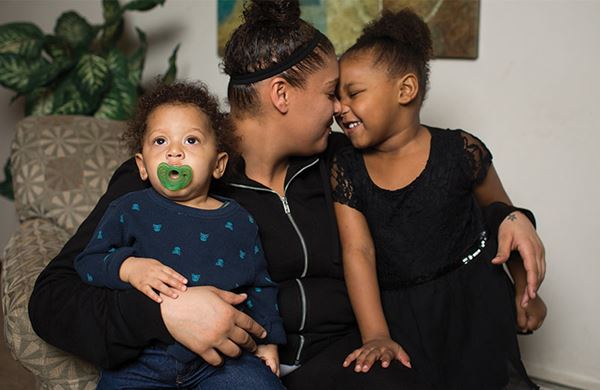An unprecedented demand for emergency family shelter
How the county is stepping up to support children and families

It is one of the county’s top priorities to ensure that families with children have access to emergency shelter. In fact, since 2005 the county has maintained a “shelter-all” policy for eligible families. Recently, that practice has been severely tested due to the unprecedented rise in families needing shelter. But the county is investing in resources and strategies to continue to serve these families in need.
There are many factors that contribute to the steep increase in demand, including the end of pandemic-related federal rent assistance, the end of the eviction moratorium, and an increasing number of families newly arriving to Minnesota who lack the supports and infrastructure to move quickly into stable housing.
“This rise in demand is not unique to Minnesota. There’s been a sharp increase in the need for family shelter across the country,” says Trish Thacker, Senior Department Administer for Well-being at the county. “As one of the few counties in the country—and the only county in Minnesota—with a shelter-all policy, we are committed to maintaining our support while thinking creatively to offer other solutions.”
To respond to the crisis, we’ve been able to increase our capacity through additional congregate crisis overnight space to help accommodate the number of families needing shelter. We’ve also been staffing up—our Housing Stability area just finished onboarding 12 new case managers focusing entirely on family shelter. Their focus will be to connect with families, offering person-centered and supportive resources to help them find stable housing. We’re also providing three meals a day, connecting families and children to schools, and coordinating transportation to get children to schools. We’re working hard to keep their education as stable as possible during this tumultuous time.
“We’re really proud to be in Hennepin County,” says Thacker, “because of the willingness to step in and say we want to prevent kids from having to sleep outside.”

People Serving People, a family shelter in Minneapolis.
Every family has different and varying reasons for why they are facing homelessness. We are organizing our response according to their needs, with strategies and programs dedicated to the new arrivals and programs dedicated to families already living in Minnesota. For new arrivals, their challenges are compounded because of restrictions on their ability to work and their immigration or asylum-seeking status. Our person-centered approach ensures that families get the tailored support they need.
“We’re constantly working to make our processes more person-centered and more efficient, helping families develop the relationships and connections they need to find and keep housing. We’re not just putting people into rooms. We’re trying to find ways to support these families and find their next level of housing.”
We hope this situation is not a “new normal.” Hennepin County continues to invest in securing overflow family shelter resources, but the supply of units – including hotel rooms – available for overflow shelter in Hennepin County can’t keep pace with demand at a time when hotel traffic is returning to pre-COVID levels. Between contracted shelter and overflow sites, we are currently at more than 400% of our normal family shelter capacity.
But Thacker remains hopeful. “The commitment level of the staff that are involved always makes me hopeful,” she said. “Everyone on the team is deeply committed to providing families with dignified care. When staffers engage with families, they come face to face with the barriers that the families have experienced. They know it’s going to be challenging. But staff are so committed to the work and they come back, day after day, to help.”
Hennepin County continues in our commitment to shelter families, and to help make homelessness in our community rare, brief, and nonrecurring. To that end, we are continuously working to help prevent family homelessness, to help families experiencing homelessness transition quickly into permanent housing, and to make that housing sustainable.
So far, the feedback from families in need has been largely one of gratitude. In a survey of the families that have experienced shelter, over 75% of respondents talked about how much they appreciated that they’re not judged and that we’re here to support.
“It’s easy for people outside the work to forget that homelessness is traumatic, for parents to be in a place where they don’t have a place to sleep and they have children to take care of—it's harrowing,” says Thacker. “When people come in, they talk about the meals they receive and the supportive people who get to know them and who build that human relationship. They see and appreciate our commitment.”